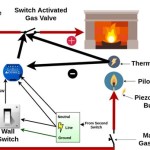Updating Your Fireplace Hearth: A Comprehensive Guide
The fireplace hearth, traditionally a protective and practical element, has evolved into a significant design feature in modern homes. It serves not only as a safety barrier against stray embers but also as a focal point, contributing significantly to the overall aesthetic of the living space. Updating a fireplace hearth can dramatically transform the look and feel of a room, offering an opportunity to introduce new materials, styles, and functionalities. This article delves into the various aspects of hearth updates, providing a comprehensive guide to help homeowners navigate the process effectively.
A hearth update can range from simple cosmetic changes, such as resurfacing or painting, to more extensive renovations involving complete replacement. The scope of the project will depend on factors such as the existing condition of the hearth, the desired aesthetic outcome, and the homeowner's budget. Prior planning and consideration of these factors are crucial for a successful and satisfying hearth update.
Assessing the Existing Hearth Condition
Before embarking on any hearth update project, a thorough assessment of the existing hearth is essential. This involves inspecting the hearth for any signs of damage, such as cracks, chips, discoloration, or structural instability. These issues not only detract from the hearth's appearance but can also compromise its safety and functionality. Identifying and addressing these problems early on will prevent them from escalating into more significant and costly repairs later.
The assessment should also consider the material of the existing hearth. Common materials include brick, stone, tile, and concrete. Each material has its own set of characteristics, including durability, maintenance requirements, and aesthetic appeal. Understanding the properties of the existing material will help determine the most appropriate update options. For example, a cracked brick hearth might require repointing or replacement of individual bricks, whereas a damaged tile hearth may necessitate a complete retiling. In situations where the existing hearth is built from solid material, such as a solid slate slab, the replacement process may be more complicated and expensive.
Furthermore, the existing hearth's dimensions and layout should be carefully considered. The size of the hearth should be proportionate to the fireplace opening and the overall room size. The layout should also complement the surrounding architecture and décor. If the existing hearth is too small or awkwardly shaped, the update project may involve expanding or reshaping it to better suit the space. Considerations of code should also be taken into account, as local building codes may stipulate minimum hearth size requirements relative to firebox opening dimensions.
Material Selection for Hearth Updates
The choice of material for a hearth update is a crucial decision that will significantly impact the final outcome. The material should be durable, heat-resistant, and aesthetically pleasing. Several options are available, each with its own advantages and disadvantages.
Brick remains a popular choice for hearth updates, offering a classic and timeless look. It is relatively affordable and durable, providing good heat resistance. Bricks can be arranged in various patterns, adding visual interest to the hearth. However, brick can be porous and may require sealing to prevent staining. It is also important to choose fire-rated bricks, particularly those rated for high temperatures, for safety.
Stone, such as granite, marble, and slate, is another excellent option for hearth updates. Stone offers a luxurious and sophisticated look, with a wide range of colors and patterns to choose from. It is highly durable and heat-resistant, making it suitable for high-heat applications. However, stone can be more expensive than brick or tile, and it may require professional installation. Stone also may require periodic sealing to prevent staining, particularly lighter and porous options, such as travertine and some types of marble.
Tile is a versatile and cost-effective option for hearth updates. Tiles are available in a wide variety of materials, including ceramic, porcelain, and natural stone. Tile offers a vast array of colors, patterns, and textures, allowing homeowners to create a unique and personalized look. It is relatively easy to install and maintain, making it a popular choice for DIY projects. However, not all tiles are suitable for hearth applications. It is important to choose tiles that are specifically designed for high-heat environments and are rated for use around fireplaces. Furthermore, grout lines may require periodic cleaning and sealing to prevent staining.
Concrete hearths have gained traction in contemporary designs. Concrete can be poured in place or pre-cast. It offers a modern, industrial aesthetic and can be stained or textured to achieve various looks. Concrete is durable and can withstand high temperatures. However, it can also be porous and may require sealing and regular maintenance.
When selecting a material, it is essential to consider the overall style of the room and the existing fireplace. The new hearth should complement the surrounding décor and create a cohesive and harmonious look.
Design Considerations and Installation Techniques
The design of the hearth update should be carefully considered to ensure that it enhances the overall aesthetic of the room. The size, shape, and layout of the hearth should be proportionate to the fireplace opening and the surrounding space. A too-small hearth may look insignificant, while a too-large hearth may overwhelm the room. Additionally, the updated hearth should comply with any local building codes and fire safety regulations.
The shape of the hearth can be either rectangular, square, curved, or custom-designed to fit the specific room and fireplace. A rectangular hearth is a classic and versatile choice that works well in most settings. A square hearth offers a more modern and geometric look. A curved hearth can add a touch of elegance and sophistication. Custom-designed hearths allow for greater flexibility and personalization, enabling homeowners to create a truly unique and eye-catching focal point.
The installation of a hearth update can be a complex process, depending on the scope of the project and the chosen materials. For simple cosmetic changes, such as painting or resurfacing, homeowners may be able to handle the project themselves. However, for more extensive renovations involving demolition, structural modifications, or complex material installations, it is highly recommended to hire a qualified and experienced contractor. A professional contractor will have the necessary skills, tools, and expertise to ensure that the project is completed safely, efficiently, and to the highest standards. The selection of a licensed and insured contractor is also an important consideration to ensure liability protection.
Proper preparation is critical for a successful hearth installation. This includes removing the existing hearth, cleaning the subfloor, and ensuring that the surface is level and stable. The new hearth material should be carefully measured and cut to size, ensuring a precise and seamless fit. Adhesives, mortar, and grout should be applied according to the manufacturer's instructions. Once the hearth is installed, it should be properly sealed and cured to protect it from damage and staining. Careful attention to detail throughout the installation process will ensure a durable and aesthetically pleasing hearth that will last for years to come.
During the installation, safety precautions are paramount. If the existing hearth contains asbestos, it must be handled and disposed of properly by a certified professional. Dust masks, gloves, and eye protection should be worn at all times during demolition and installation to prevent exposure to harmful materials. Adequate ventilation should be provided to avoid inhaling dust and fumes. The area around the fireplace should be cordoned off to prevent accidents and injuries.
Following the hearth update, regular maintenance is essential to preserve its appearance and functionality. This includes cleaning the hearth regularly with appropriate cleaning products, sealing it periodically to prevent staining, and inspecting it for any signs of damage. Promptly addressing any issues will prevent them from escalating into more significant problems. With proper care and maintenance, an updated fireplace hearth can provide years of enjoyment and enhance the beauty and value of the home.

Updating Fireplace Hearth No Demolition Required Single Girl S Diy

How To Update The Look Of Your Fireplace

Fireplace Update Ideas Stoll Industries Made In The Usa
5 Amazing Inexpensive Easy Fireplace Remodel Transformations Designed

How To Update A Fireplace On Budget Home Matters Ahs

Fireplace Makeover Update Rustic Mantel Beam The Lettered Cottage

Modern Fireplace Makeover Remodel Home Brick

Fireplace Update Before Afters Luce S Chimney Stove

Updating Fireplace Hearth No Demolition Required Single Girl S Diy

30 Fireplace Remodel Ideas For Any Budget








